Healthcare: Introduction to Patient Safety and Root Cause Analysis
VerifiedAdded on 2022/08/28
|5
|1063
|21
Report
AI Summary
This report provides an introduction to patient safety, focusing on the application of Root Cause Analysis (RCA) in healthcare settings. It defines RCA as a framework for identifying and solving problems by determining the root causes of issues to improve patient outcomes. The report highlights the benefits of RCA, including enhanced efficiency, the promotion of accountability among healthcare professionals, and the establishment of a competitive healthcare system. It emphasizes how RCA helps in identifying the origins of problems, reducing medical errors, and improving treatment success. The report concludes by stressing the importance of RCA as a tool for improving patient safety and decision-making in healthcare. References to supporting literature and studies are included.
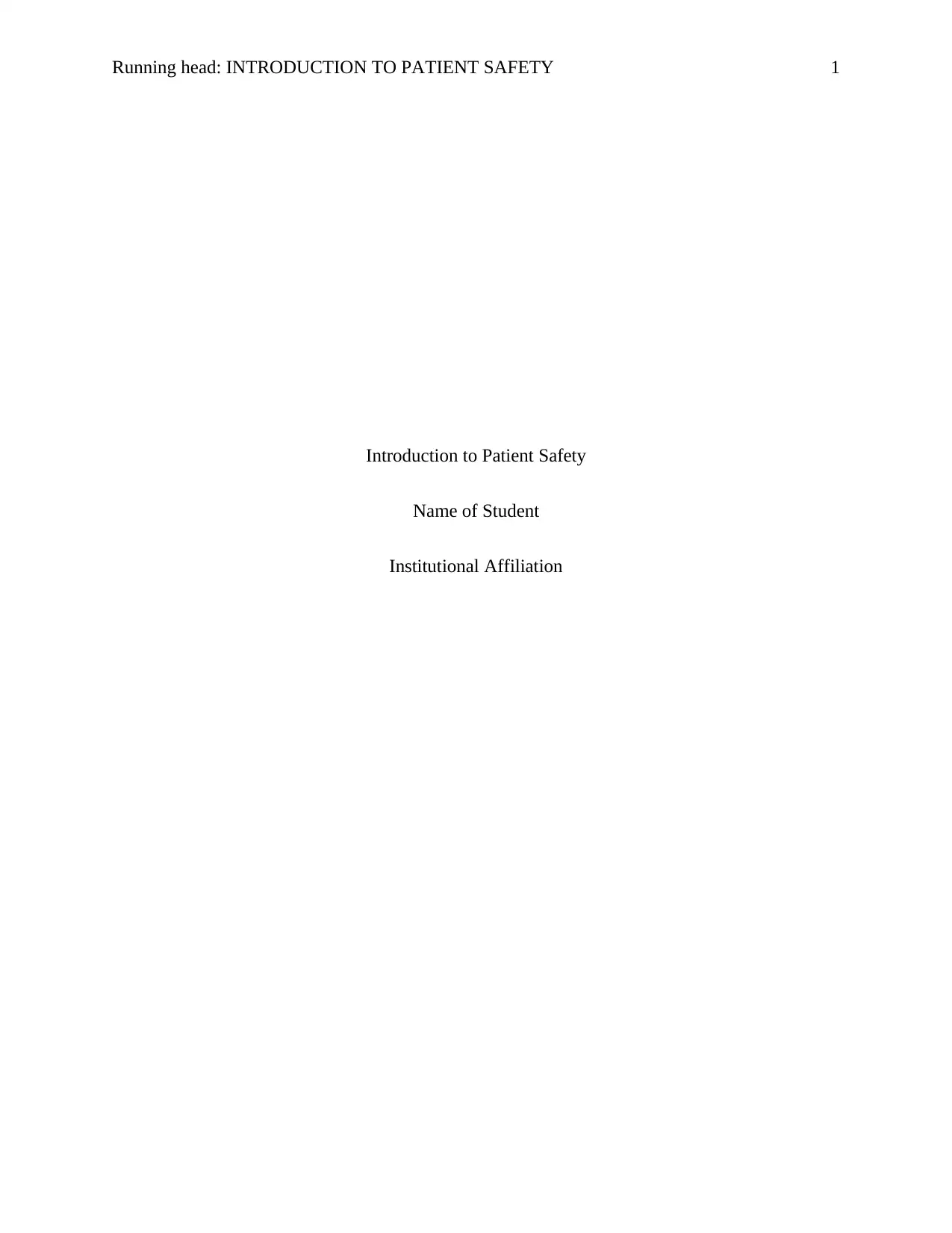
Running head: INTRODUCTION TO PATIENT SAFETY 1
Introduction to Patient Safety
Name of Student
Institutional Affiliation
Introduction to Patient Safety
Name of Student
Institutional Affiliation
Paraphrase This Document
Need a fresh take? Get an instant paraphrase of this document with our AI Paraphraser
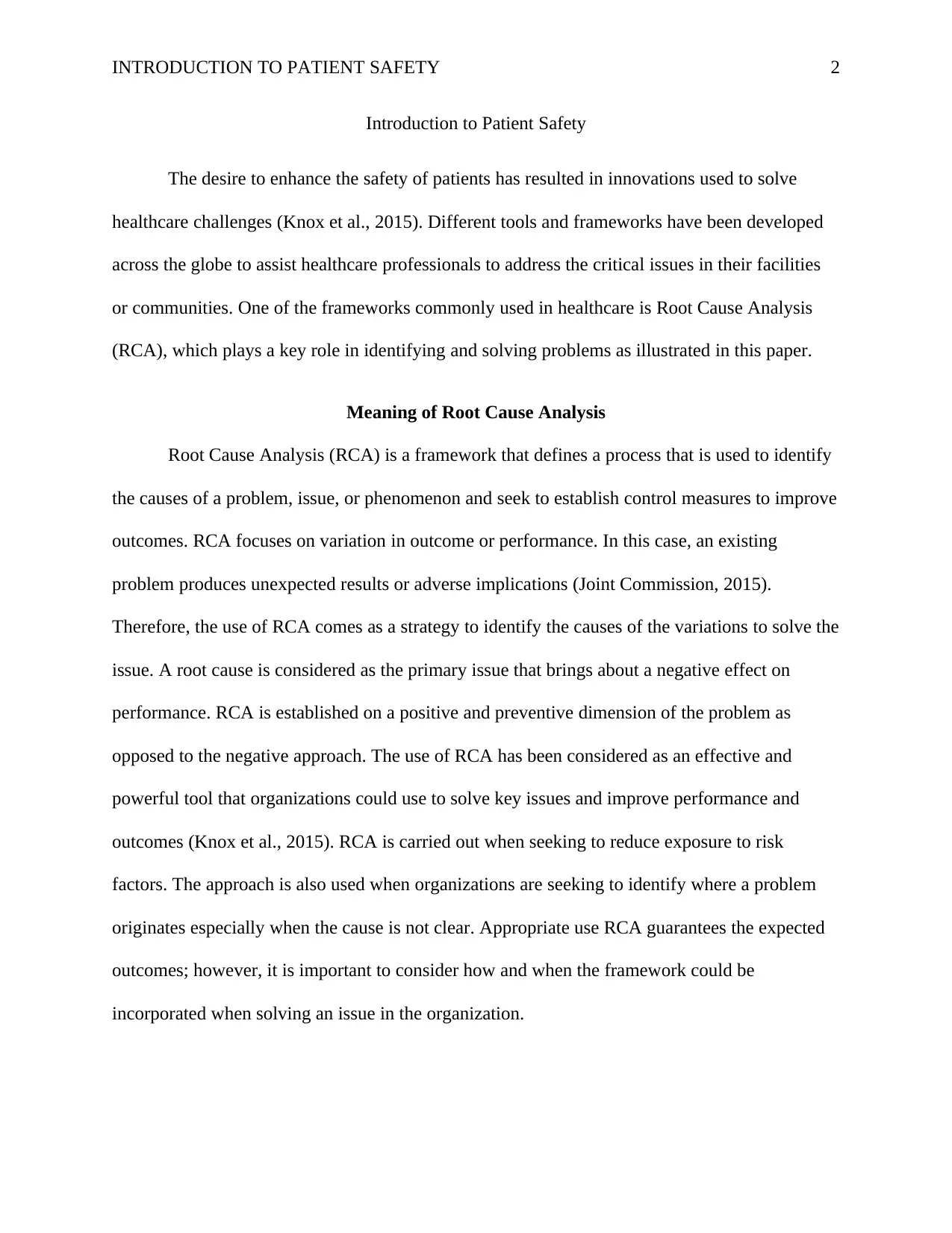
INTRODUCTION TO PATIENT SAFETY 2
Introduction to Patient Safety
The desire to enhance the safety of patients has resulted in innovations used to solve
healthcare challenges (Knox et al., 2015). Different tools and frameworks have been developed
across the globe to assist healthcare professionals to address the critical issues in their facilities
or communities. One of the frameworks commonly used in healthcare is Root Cause Analysis
(RCA), which plays a key role in identifying and solving problems as illustrated in this paper.
Meaning of Root Cause Analysis
Root Cause Analysis (RCA) is a framework that defines a process that is used to identify
the causes of a problem, issue, or phenomenon and seek to establish control measures to improve
outcomes. RCA focuses on variation in outcome or performance. In this case, an existing
problem produces unexpected results or adverse implications (Joint Commission, 2015).
Therefore, the use of RCA comes as a strategy to identify the causes of the variations to solve the
issue. A root cause is considered as the primary issue that brings about a negative effect on
performance. RCA is established on a positive and preventive dimension of the problem as
opposed to the negative approach. The use of RCA has been considered as an effective and
powerful tool that organizations could use to solve key issues and improve performance and
outcomes (Knox et al., 2015). RCA is carried out when seeking to reduce exposure to risk
factors. The approach is also used when organizations are seeking to identify where a problem
originates especially when the cause is not clear. Appropriate use RCA guarantees the expected
outcomes; however, it is important to consider how and when the framework could be
incorporated when solving an issue in the organization.
Introduction to Patient Safety
The desire to enhance the safety of patients has resulted in innovations used to solve
healthcare challenges (Knox et al., 2015). Different tools and frameworks have been developed
across the globe to assist healthcare professionals to address the critical issues in their facilities
or communities. One of the frameworks commonly used in healthcare is Root Cause Analysis
(RCA), which plays a key role in identifying and solving problems as illustrated in this paper.
Meaning of Root Cause Analysis
Root Cause Analysis (RCA) is a framework that defines a process that is used to identify
the causes of a problem, issue, or phenomenon and seek to establish control measures to improve
outcomes. RCA focuses on variation in outcome or performance. In this case, an existing
problem produces unexpected results or adverse implications (Joint Commission, 2015).
Therefore, the use of RCA comes as a strategy to identify the causes of the variations to solve the
issue. A root cause is considered as the primary issue that brings about a negative effect on
performance. RCA is established on a positive and preventive dimension of the problem as
opposed to the negative approach. The use of RCA has been considered as an effective and
powerful tool that organizations could use to solve key issues and improve performance and
outcomes (Knox et al., 2015). RCA is carried out when seeking to reduce exposure to risk
factors. The approach is also used when organizations are seeking to identify where a problem
originates especially when the cause is not clear. Appropriate use RCA guarantees the expected
outcomes; however, it is important to consider how and when the framework could be
incorporated when solving an issue in the organization.
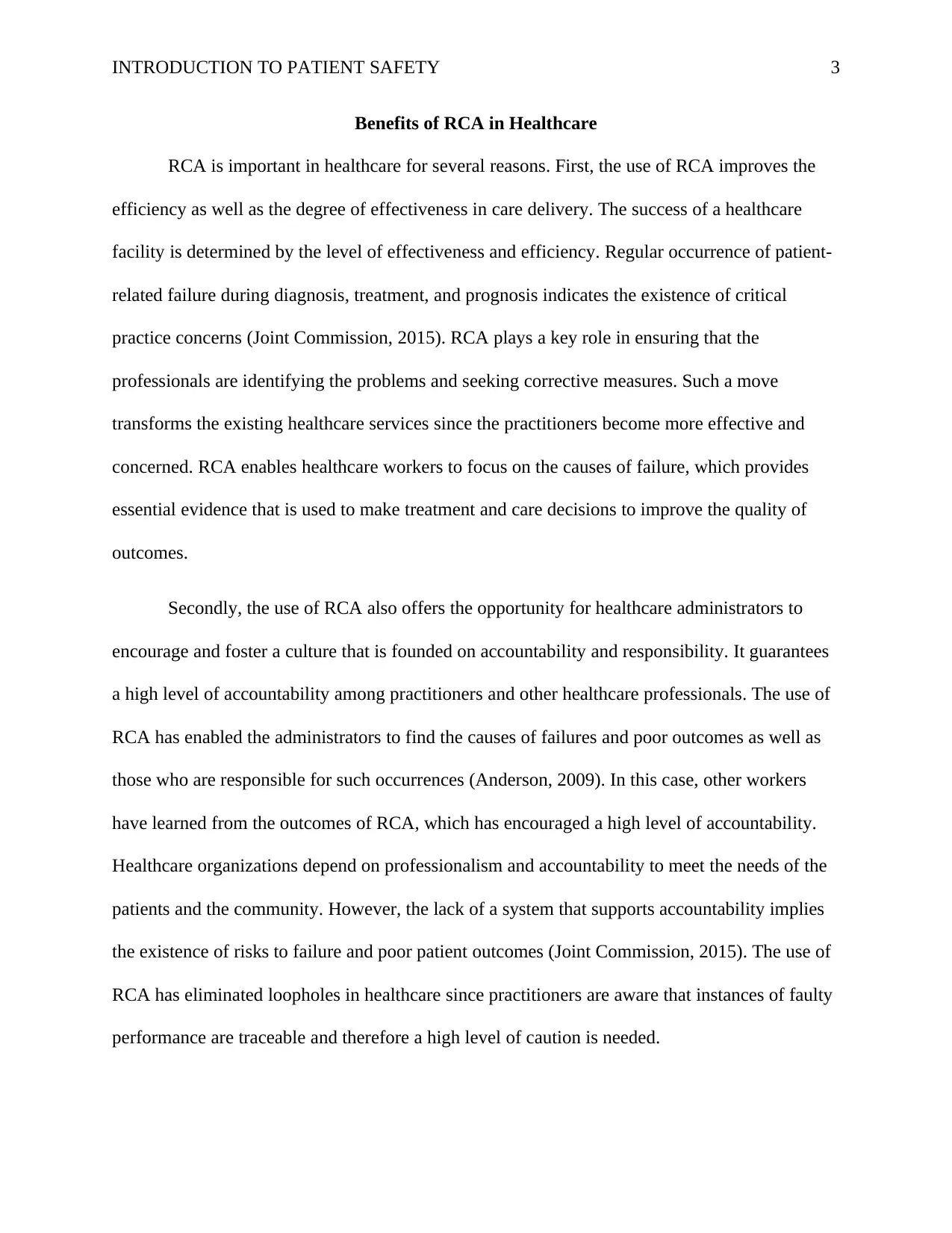
INTRODUCTION TO PATIENT SAFETY 3
Benefits of RCA in Healthcare
RCA is important in healthcare for several reasons. First, the use of RCA improves the
efficiency as well as the degree of effectiveness in care delivery. The success of a healthcare
facility is determined by the level of effectiveness and efficiency. Regular occurrence of patient-
related failure during diagnosis, treatment, and prognosis indicates the existence of critical
practice concerns (Joint Commission, 2015). RCA plays a key role in ensuring that the
professionals are identifying the problems and seeking corrective measures. Such a move
transforms the existing healthcare services since the practitioners become more effective and
concerned. RCA enables healthcare workers to focus on the causes of failure, which provides
essential evidence that is used to make treatment and care decisions to improve the quality of
outcomes.
Secondly, the use of RCA also offers the opportunity for healthcare administrators to
encourage and foster a culture that is founded on accountability and responsibility. It guarantees
a high level of accountability among practitioners and other healthcare professionals. The use of
RCA has enabled the administrators to find the causes of failures and poor outcomes as well as
those who are responsible for such occurrences (Anderson, 2009). In this case, other workers
have learned from the outcomes of RCA, which has encouraged a high level of accountability.
Healthcare organizations depend on professionalism and accountability to meet the needs of the
patients and the community. However, the lack of a system that supports accountability implies
the existence of risks to failure and poor patient outcomes (Joint Commission, 2015). The use of
RCA has eliminated loopholes in healthcare since practitioners are aware that instances of faulty
performance are traceable and therefore a high level of caution is needed.
Benefits of RCA in Healthcare
RCA is important in healthcare for several reasons. First, the use of RCA improves the
efficiency as well as the degree of effectiveness in care delivery. The success of a healthcare
facility is determined by the level of effectiveness and efficiency. Regular occurrence of patient-
related failure during diagnosis, treatment, and prognosis indicates the existence of critical
practice concerns (Joint Commission, 2015). RCA plays a key role in ensuring that the
professionals are identifying the problems and seeking corrective measures. Such a move
transforms the existing healthcare services since the practitioners become more effective and
concerned. RCA enables healthcare workers to focus on the causes of failure, which provides
essential evidence that is used to make treatment and care decisions to improve the quality of
outcomes.
Secondly, the use of RCA also offers the opportunity for healthcare administrators to
encourage and foster a culture that is founded on accountability and responsibility. It guarantees
a high level of accountability among practitioners and other healthcare professionals. The use of
RCA has enabled the administrators to find the causes of failures and poor outcomes as well as
those who are responsible for such occurrences (Anderson, 2009). In this case, other workers
have learned from the outcomes of RCA, which has encouraged a high level of accountability.
Healthcare organizations depend on professionalism and accountability to meet the needs of the
patients and the community. However, the lack of a system that supports accountability implies
the existence of risks to failure and poor patient outcomes (Joint Commission, 2015). The use of
RCA has eliminated loopholes in healthcare since practitioners are aware that instances of faulty
performance are traceable and therefore a high level of caution is needed.
⊘ This is a preview!⊘
Do you want full access?
Subscribe today to unlock all pages.

Trusted by 1+ million students worldwide
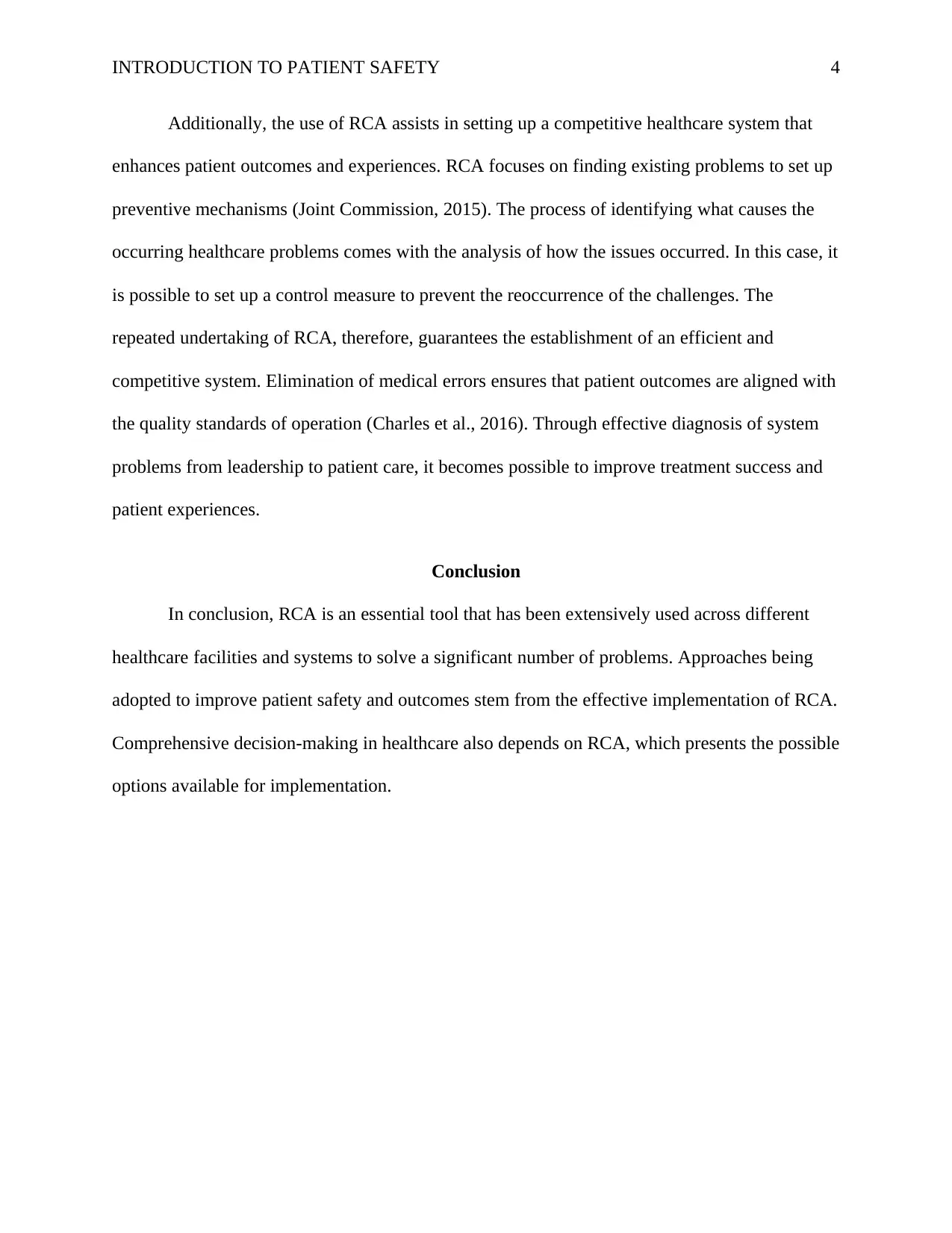
INTRODUCTION TO PATIENT SAFETY 4
Additionally, the use of RCA assists in setting up a competitive healthcare system that
enhances patient outcomes and experiences. RCA focuses on finding existing problems to set up
preventive mechanisms (Joint Commission, 2015). The process of identifying what causes the
occurring healthcare problems comes with the analysis of how the issues occurred. In this case, it
is possible to set up a control measure to prevent the reoccurrence of the challenges. The
repeated undertaking of RCA, therefore, guarantees the establishment of an efficient and
competitive system. Elimination of medical errors ensures that patient outcomes are aligned with
the quality standards of operation (Charles et al., 2016). Through effective diagnosis of system
problems from leadership to patient care, it becomes possible to improve treatment success and
patient experiences.
Conclusion
In conclusion, RCA is an essential tool that has been extensively used across different
healthcare facilities and systems to solve a significant number of problems. Approaches being
adopted to improve patient safety and outcomes stem from the effective implementation of RCA.
Comprehensive decision-making in healthcare also depends on RCA, which presents the possible
options available for implementation.
Additionally, the use of RCA assists in setting up a competitive healthcare system that
enhances patient outcomes and experiences. RCA focuses on finding existing problems to set up
preventive mechanisms (Joint Commission, 2015). The process of identifying what causes the
occurring healthcare problems comes with the analysis of how the issues occurred. In this case, it
is possible to set up a control measure to prevent the reoccurrence of the challenges. The
repeated undertaking of RCA, therefore, guarantees the establishment of an efficient and
competitive system. Elimination of medical errors ensures that patient outcomes are aligned with
the quality standards of operation (Charles et al., 2016). Through effective diagnosis of system
problems from leadership to patient care, it becomes possible to improve treatment success and
patient experiences.
Conclusion
In conclusion, RCA is an essential tool that has been extensively used across different
healthcare facilities and systems to solve a significant number of problems. Approaches being
adopted to improve patient safety and outcomes stem from the effective implementation of RCA.
Comprehensive decision-making in healthcare also depends on RCA, which presents the possible
options available for implementation.
Paraphrase This Document
Need a fresh take? Get an instant paraphrase of this document with our AI Paraphraser
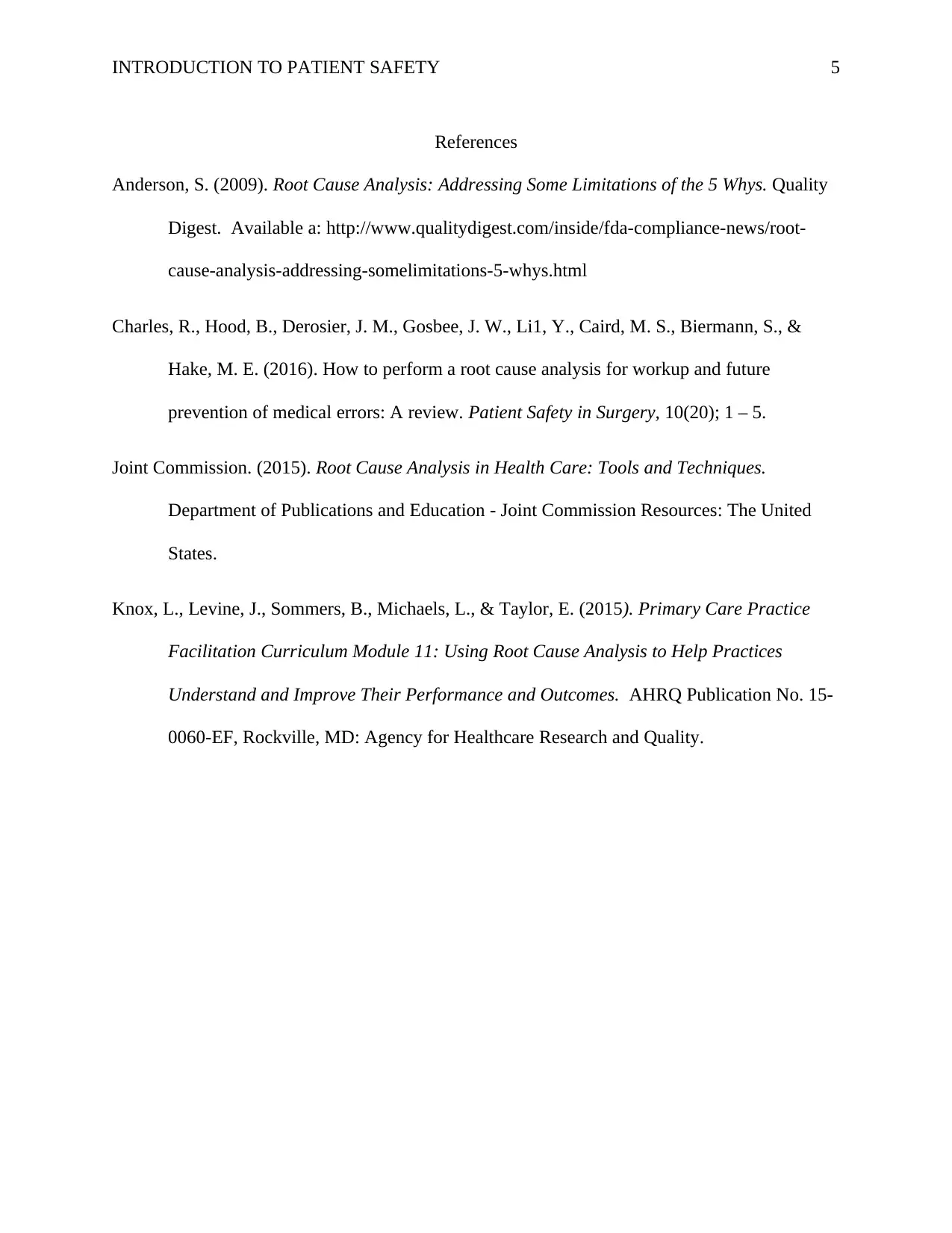
INTRODUCTION TO PATIENT SAFETY 5
References
Anderson, S. (2009). Root Cause Analysis: Addressing Some Limitations of the 5 Whys. Quality
Digest. Available a: http://www.qualitydigest.com/inside/fda-compliance-news/root-
cause-analysis-addressing-somelimitations-5-whys.html
Charles, R., Hood, B., Derosier, J. M., Gosbee, J. W., Li1, Y., Caird, M. S., Biermann, S., &
Hake, M. E. (2016). How to perform a root cause analysis for workup and future
prevention of medical errors: A review. Patient Safety in Surgery, 10(20); 1 – 5.
Joint Commission. (2015). Root Cause Analysis in Health Care: Tools and Techniques.
Department of Publications and Education - Joint Commission Resources: The United
States.
Knox, L., Levine, J., Sommers, B., Michaels, L., & Taylor, E. (2015). Primary Care Practice
Facilitation Curriculum Module 11: Using Root Cause Analysis to Help Practices
Understand and Improve Their Performance and Outcomes. AHRQ Publication No. 15-
0060-EF, Rockville, MD: Agency for Healthcare Research and Quality.
References
Anderson, S. (2009). Root Cause Analysis: Addressing Some Limitations of the 5 Whys. Quality
Digest. Available a: http://www.qualitydigest.com/inside/fda-compliance-news/root-
cause-analysis-addressing-somelimitations-5-whys.html
Charles, R., Hood, B., Derosier, J. M., Gosbee, J. W., Li1, Y., Caird, M. S., Biermann, S., &
Hake, M. E. (2016). How to perform a root cause analysis for workup and future
prevention of medical errors: A review. Patient Safety in Surgery, 10(20); 1 – 5.
Joint Commission. (2015). Root Cause Analysis in Health Care: Tools and Techniques.
Department of Publications and Education - Joint Commission Resources: The United
States.
Knox, L., Levine, J., Sommers, B., Michaels, L., & Taylor, E. (2015). Primary Care Practice
Facilitation Curriculum Module 11: Using Root Cause Analysis to Help Practices
Understand and Improve Their Performance and Outcomes. AHRQ Publication No. 15-
0060-EF, Rockville, MD: Agency for Healthcare Research and Quality.
1 out of 5
Related Documents
Your All-in-One AI-Powered Toolkit for Academic Success.
+13062052269
info@desklib.com
Available 24*7 on WhatsApp / Email
![[object Object]](/_next/static/media/star-bottom.7253800d.svg)
Unlock your academic potential
Copyright © 2020–2025 A2Z Services. All Rights Reserved. Developed and managed by ZUCOL.





